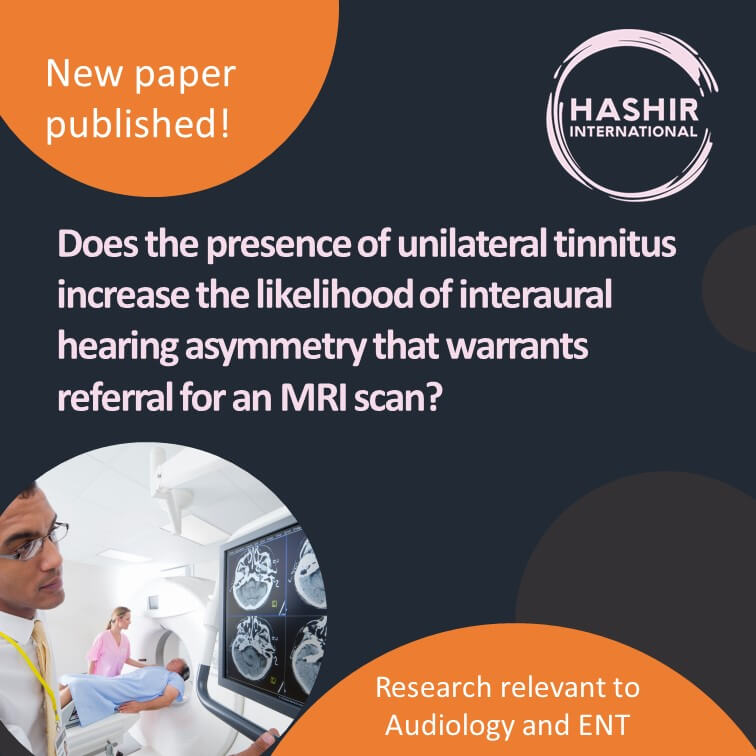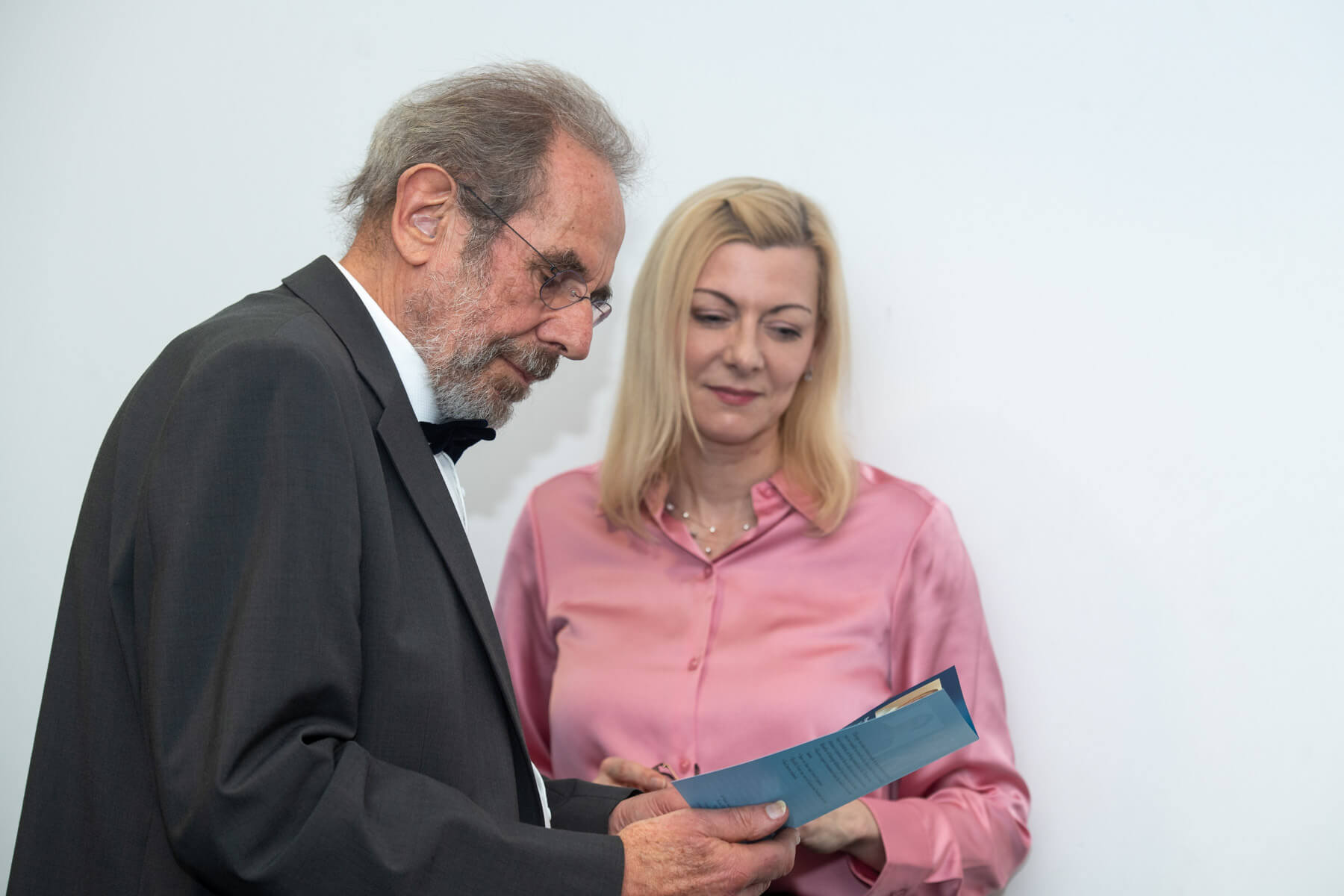May 7, 2024 at 8:50 pm

Researchers at Hashir International Institute in collaboration with audiologists at University of Pretoria, South Africa, Florida Atlantic University, USA and the Royal Surrey NHS Foundation Trust, Guildford conducted a study assessing the differences in tinnitus impact, hyperacusis and hearing threshold level between patients with unilateral and bilateral tinnitus.
This study has been published in International Journal of Audiology, May 2024, and its full text is freely available by clicking here.
NICE guideline (National Institute for Health and Care Excellence) recommends conducting pure tone audiometry for patients with unilateral tinnitus to assess whether the hearing loss is asymmetrical. They suggest that if the between-ear difference is equal or more than 15 dB at two or more adjacent frequencies, the patient should be referred for Magnetic Resonance Imaging (MRI). The British Academy of Audiology (BAA) also suggests that if the between-ear difference is equal or more than 15 dB at two or more adjacent frequencies, the patient should be referred for MRI. It is important to note that NICE has a lighter recommendation to “consider” MRI” for symmetrical hearing and unilateral tinnitus.
It is not clear how much unilateral versus bilateral tinnitus affects the risk of having an asymmetry in hearing thresholds of ≥15 dB for at least two adjacent frequencies. For this study, the data for over 300 patients with tinnitus were analysed. Majority of patients (61.5%) presented with bilateral tinnitus.

Our Director, Dr Hashir Aazh said:
“This is an important clinical question. General practitioners sometimes need to prioritise diagnostic tests for their patients. If the risk of having an asymmetry in hearing thresholds of ≥15 dB for at least two adjacent frequencies is proved to be higher in patients with unilateral tinnitus, then they can be prioritised to have audiometry followed by MRI scan [if indicated]. It is worth mentioning that having an asymmetry in hearing thresholds of ≥15 dB for at least two adjacent frequencies can predict vestibular schwannomas with a sensitivity of 89% and a specificity of 45.5%.”
The study showed that that unilateral tinnitus is associated with increased interaural asymmetry in hearing thresholds. The multinomial logistic regression analyses showed that the presence of unilateral tinnitus significantly increased the risk of having an asymmetry in hearing thresholds of ≥15 dB for at least two adjacent frequencies. Therefore, audiological investigation, especially for those with unilateral tinnitus, is recommended.

Dr Christine Louw from University of Pretoria, South Africa, said:
“This study showed that tinnitus tended to be heard in the ear with the greater hearing loss and the slope of audiogram was on average greater for the ears with tinnitus. Interestingly, hyperacusis symptoms were more prevalent for patients with bilateral tinnitus. Our study showed no difference between patients with unilateral and bilateral tinnitus in the impact of tinnitus and symptoms of anxiety and depression as measured via the Tinnitus Impact Questionnaire (TIQ), visual analogue scale of tinnitus loudness (VAS) and screening for anxiety and depression in tinnitus questionnaire (SAD-T). One limitation for this study is that all patients were referred to an audiology clinic for tinnitus and/or hyperacusis management. Therefore, the results are probably not representative of all patients with tinnitus.”
There was no significant difference in the impact of tinnitus as measured via TIQ, VAS and SAD-T between those with unilateral and bilateral tinnitus. Therefore, audiologist-delivered cognitive behavioural therapy (CBT) is likely to have similar effectiveness for patients with unilateral and bilateral tinnitus.
 Professor Brian C.J. Moore, who is Honorary Hearing Research Consultant at Hashir International, adds:
Professor Brian C.J. Moore, who is Honorary Hearing Research Consultant at Hashir International, adds:
“Patients whose primary complaint is tinnitus do not always receive an audiological evaluation. Our analyses show that unilateral tinnitus, i.e. tinnitus perceived on one side only, is associated with an increased risk of having a difference in audiometric threshold across the two ears of 20 dB or 15 dB for two adjacent frequencies (denoted 2AF20 and 2AF15, respectively). Such interaural asymmetry is in turn associated with an increased risk of a disorder that may require treatment, such as vestibular schwannoma or Meniere’s disease. Hence, we recommend that patients with unilateral tinnitus have a full audiological evaluation, which might lead to further tests, such as an MRI scan.”
For further information, please contact:
Hashir International Institute, 167-169 Great Portland Street, 5th Floor, London, W1W 5PF
Hashir International Institute, 54 Quarry Street, Guildford. GU1 3UA
admin@hashirtinnitusclinic.com
About Hashir International:
Hashir International is an independent research institute and treatment centre dedicated to improving the diagnostic process and rehabilitation programs for patients experiencing misophonia, tinnitus and hyperacusis. They offer specialist training courses, ethical review of research proposals, research design, research sponsorship, and supervising MSc and PhD students.